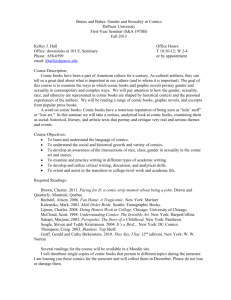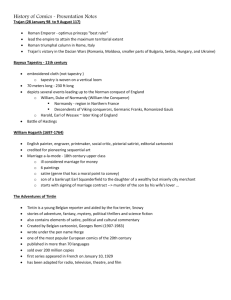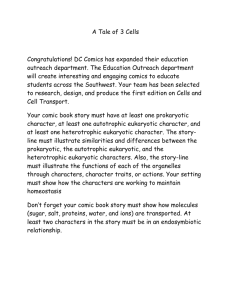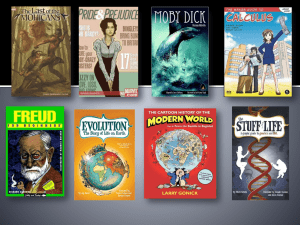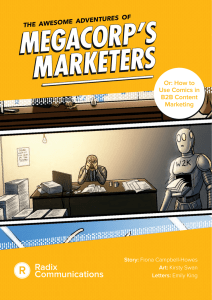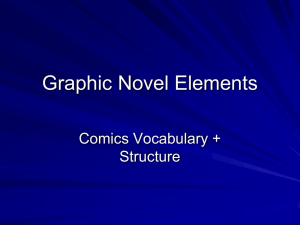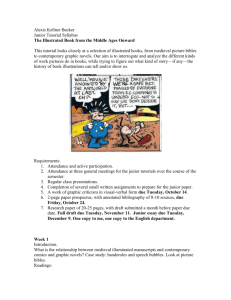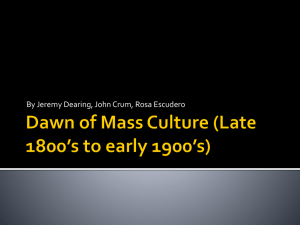Comic Books in American Society
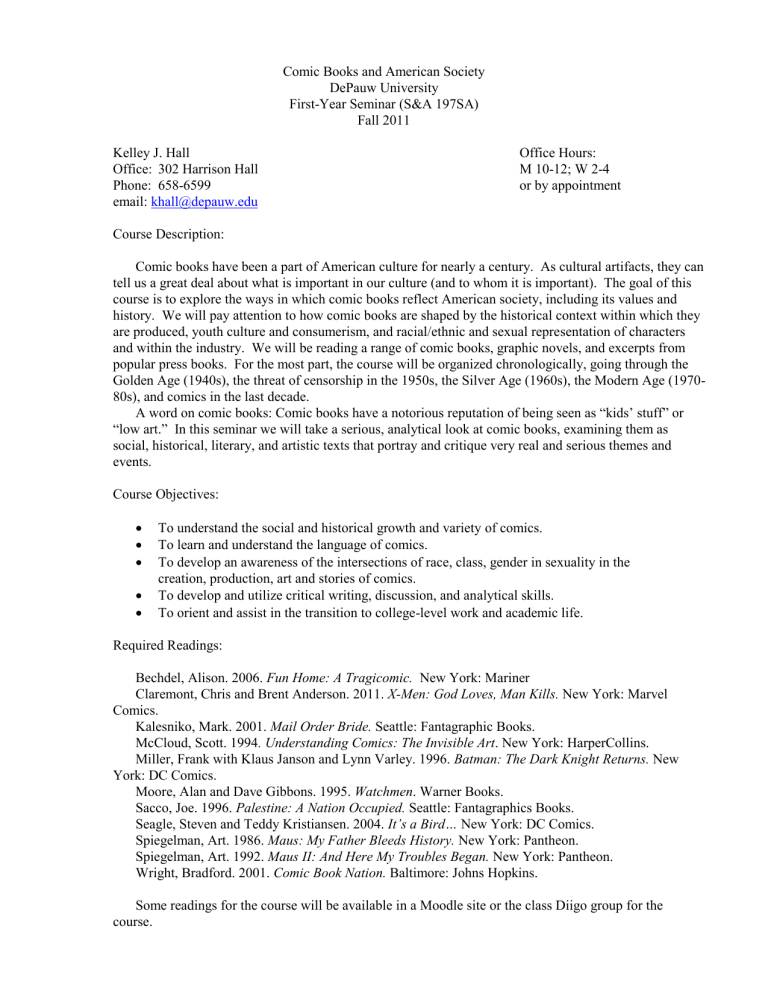
Comic Books and American Society
DePauw University
First-Year Seminar (S&A 197SA)
Fall 2011
Kelley J. Hall
Office: 302 Harrison Hall
Phone: 658-6599 email: khall@depauw.edu
Course Description:
Office Hours:
M 10-12; W 2-4 or by appointment
Comic books have been a part of American culture for nearly a century. As cultural artifacts, they can tell us a great deal about what is important in our culture (and to whom it is important). The goal of this course is to explore the ways in which comic books reflect American society, including its values and history. We will pay attention to how comic books are shaped by the historical context within which they are produced, youth culture and consumerism, and racial/ethnic and sexual representation of characters and within the industry. We will be reading a range of comic books, graphic novels, and excerpts from popular press books. For the most part, the course will be organized chronologically, going through the
Golden Age (1940s), the threat of censorship in the 1950s, the Silver Age (1960s), the Modern Age (1970-
80s), and comics in the last decade.
A word on comic books: Comic books have a notorious reputation of being seen as “kids’ stuff” or
“low art.” In this seminar we will take a serious, analytical look at comic books, examining them as social, historical, literary, and artistic texts that portray and critique very real and serious themes and events.
Course Objectives:
To understand the social and historical growth and variety of comics.
To learn and understand the language of comics.
To develop an awareness of the intersections of race, class, gender in sexuality in the creation, production, art and stories of comics.
To develop and utilize critical writing, discussion, and analytical skills.
To orient and assist in the transition to college-level work and academic life.
Required Readings:
Bechdel, Alison. 2006. Fun Home: A Tragicomic.
New York: Mariner
Claremont, Chris and Brent Anderson. 2011. X-Men: God Loves, Man Kills. New York: Marvel
Comics.
Kalesniko, Mark. 2001. Mail Order Bride.
Seattle: Fantagraphic Books.
McCloud, Scott. 1994 . Understanding Comics: The Invisible Art . New York: HarperCollins.
Miller, Frank with Klaus Janson and Lynn Varley. 1996. Batman: The Dark Knight Returns.
New
York: DC Comics.
Moore, Alan and Dave Gibbons. 1995. Watchmen . Warner Books.
Sacco, Joe. 1996. Palestine: A Nation Occupied.
Seattle: Fantagraphics Books.
Seagle, Steven and Teddy Kristiansen. 2004.
It’s a Bird… New York: DC Comics.
Spiegelman, Art. 1986. Maus: My Father Bleeds History.
New York: Pantheon.
Spiegelman, Art. 1992. Maus II: And Here My Troubles Began.
New York: Pantheon.
Wright, Bradford. 2001. Comic Book Nation.
Baltimore: Johns Hopkins.
Some readings for the course will be available in a Moodle site or the class Diigo group for the course.
Comic Packet (CP): You will receive a packet of loose, single copies of comic books that pertain to different topics during the semester. I am loaning you these comics for the semester and will collect them in December. Please do not lose or damage them.
Course Requirements:
1. Daily Preparation, Attendance, and Participation (35 points): Class participation, which means active and thoughtful involvement in the class discussions and activities, is an important part of your grade
. A seminar is a learning environment in which the priority is the discussion of course materials. While I will give some lecture during the semester, I see my primary role as the facilitator of class discussion. As members of a small seminar, the success of the class on any given day depends on the preparation of all members. Writing up your thoughts about the readings contributes to this process because you enter into the discussion with a clear idea of questions and comments you would like to raise. Therefore, you should be prepared to comment, critique, or raise questions about the readings.
Clearly your attendance is essential for this portion of your grade.
To aid in class discussion, this course will use the social bookmarking tool Diigo, to post, annotate, share and discuss online materials such as academic and pop culture articles, YouTube videos, cartoons, advertisements, historical documents and more. Each student will be assigned to a group that will be responsible for posting materials to Diigo by 8pm the day before class (Monday or
Wednesday). Each group member should post at least one item with relevant insights for their assignment and class members should respond, comment or otherwise engage in dialogue about those posts. Everyone in the class is responsible for checking and responding thoughtfully to Diigo entries.
The minimum requirement is once a week—I would like to see more than that from each student.
However, one insightful post is better than several unrelated throw-away posts. I will announce Diigo discussion topics in class. These topics will serve as in-class activities or short homework assignments.
My goal is that class members will supply relevant, insightful research, information or examples that we can critique, connect and apply to the course and beyond. The larger goal is that we will create a learning community where we share information and resources—relevant tags (or keywords) will help us achieve this. This is a rubric for social bookmarking, for examining the process of recording and remembering key sites and URL's. The activity is in its simplest form at remembering level but as we add detail, explanations and structure it advances into understanding .
Level Bookmarking
The user adds site to Favorites (Internet Explorer) or Bookmarks (Firefox) or
1
2
3 adds URL to social bookmarking site. The user does not add tags (keywords) or comments. These locally stored bookmarks lack structure or organization.
The user adds a site to the Favorites or Bookmarks. The bookmarks are organized into appropriately-named folders. Or the user adds the URL to social bookmarking site. The user sometimes adds either tags or comments.
The resources are added regardless of their validity or connection to course content or topics.
The user adds URL to a social bookmarking site. The student adds tags or comments. Tags are mostly well-constructed and suitable keywords. There is some shared/common use of tags (e.g. singular and plural keywords). There is some limited filtering on basis of validity to the course and unique disciplinary
4 background (attempts validation). The comments or notes are simple. The user shares the bookmark with all members of their network
The user adds URL to a social bookmarking site and adds detailed, insightful comments and appropriate tags. The comments summarize the resource well and there is consistent use of shared/common tags with solid connection and validity to the course content and unique disciplinary background. The student shares the bookmark with appropriate members of their network.
2.
Friday Memos (10 points each): You are required to write six memos discussing the week’s readings during the semester (2-3 typed pages each). Each week’s memo must be emailed to me
(khall@depauw.edu) before noon on Friday ; I will not accept late memos. You must complete at least three memos before Fall Break—I will not accept more than three memos after that point of the semester.
These memos need not be summaries of the week’s readings. In fact, memos that include reactions to specific arguments, comparisons between authors/creators, or applications/connections to previous readings or everyday life outside this course will earn better scores. In short, be critical and insightful about what you discuss in your memos. Use and cite course readings correctly. Be creative. Don’t regurgitate.
3. Two Reviews (20 and 30 points): You will critically review two graphic novels that we read this semester. I will hand out detailed instructions in class. (One rule: you can’t review Maus I and Maus II .)
4. In-Class Presentation (30 points): After fall break, you and a partner (or two) will give a presentation on one of the graphic novels we’ll be covering. For this presentation you are responsible for biographical details and art/writing styles the creator, and the creative and/or historical significance of the graphic novel within comic book history or industry, and/or within its particular genre. In short, you will be giving us a critical analysis of the creator and his or her work and where they fit into the realm of comics. This presentation will last 15-20 minutes. In addition , you and your partner will be primarily responsible for facilitating in-class discussion of the graphic novel.
5. Midterm Take-Home Exam (30 points): There will be a take-home midterm exam that covers significant concepts and ideas from the first half of the semester.
6. Final Project (50 points): You will be required to complete a final project related to the course content. The format and topic of the final project will be fairly open and creative, ranging from a standard research paper to the detailed conceptualization of your own comic book. Instructions for this assignment will be handed out in class.
Add it up
Grading Scale:
Daily Participation and Preparation 35 points
Friday Memos (6 x 10 points)
Review #1
Review #2
Presentation and Facilitation
Midterm Take-Home Exam
Final Project
94-100% = A
90-93 = A-
87-89 = B+
84-86 = B
80-83 = B-
77-79 = C+
74-76 = C
70-73 = C-
60 points
20 points
30 points
30 points
30 points
50 points
Total: 255 points
67-69 = D+
64-66 = D
60-63 = D-
0-59 = F
Grading Criteria:
These criteria apply to all assignments (including essays, exam responses, Diigo posts) and correspond to the percentages above:
A- to A: means that the piece successfully captured the main points of the readings and that they were connected to the assignment. The paper illustrates clear and relevant insights and understanding and shows that the writer thought carefully about what he or she was going to write.
The paper is exceptionally thought-provoking, original, and lucid in content and organization. The paper has something to say, and says it clearly and gracefully to an appropriate audience; it is
supported fully by sources and appropriate examples. This grade also indicates exceptional writing skills in terms of clarity, grammar, and punctuation.
B- to B+: means that the piece accurately captured the main points of the readings and that they were connected to the assignment. The paper illustrates that the writer thought about the readings
(and what they meant) and that he or she made an attempt to connect it to course concepts and issues.
The paper is solid and well-organized but not striking; the writer has a definite point to make and makes it in an organized and competent way. This grade also demonstrates good writing skills in terms of clarity, grammar, and punctuation.
C- to C+: means that the piece did not quite capture the main points of the readings accurately and/or didn’t attend carefully to the requirements of the assignment. It seems from the piece that the writer did not understand the readings and/or think carefully about linking it to course concepts and issues. The content and organization is weak, fuzzy, or illogical. Examples are given for their own sake or to demonstrate that the writer read the text, not to make a point. This grade may also indicate writing problems in terms of clarity, grammar, and punctuation.
D- to D+: means that the paper shows blatant inaccuracies regarding the readings, the writer did not complete part of the assignment, and/or that writing problems impede my ability to understand the piece. The paper is much shorter than the assigned length and appears as though there isn’t a point to the paper. This grade may also indicate serious writing problems in terms of clarity, grammar, and punctuation.
F: means that the paper is plagiarized in part or as a whole (see Academic Integrity Policy below), or it shows general weaknesses ever graver than those of a D paper.
Course Policies:
Consistent tardiness and unexcused absences will negatively affect your final grade. Excused absences must be discussed with me in advance, and that does not guarantee your absence will be excused.
All writing assignments must be turned in on their announced due dates. Without a reasonable excuse discussed with me in advance, failure to turn in assignments on time will result in a five-point reduction in your score on that assignment per class day late. I will not accept small overnight, takehome assignments.
You are responsible for material discussed and/or assigned when you are absent. If you are absent, contact a classmate to double check reading or homework assignments.
DePauw University is committed to providing equal access to academic programs and University administered activities and reasonable accommodations to students with disabilities, in compliance with the Americans With Disabilities Act and Amendments (ADAAA). If you feel you need an accommodation based on the impact of a disability or learning challenge you are strongly encouraged to contact Pamela Roberts, Coordinator of Academic Success and Student Disability Services, for further information on how to receive accommodations and support. Academic Success and Student
Disability Services is located in Harrison Hall, 302 A, 765-658-6267 .
Academic Integrity:
I will not tolerate academic dishonesty (and you shouldn’t either). Cheating, plagiarism, presenting another person’s work as your own, etc. violates DePauw University’s policy on academic integrity and will result in penalties ranging from a zero on the assignment to course failure or expulsion. Presenting your own work as something new (i.e., “recycling” a paper from another course) is also unacceptable.
See the policy and discussion of students’ obligations and rights in the Student Handbook. Be sure to follow guidelines for proper citation of sources in your writing. If you are unsure what constitutes plagiarism, representing another’s work as your own, “recycling,” etc., see me.
Course Schedule (tentative)
Aug. 25 Introductions and Course Overview
Diigo Instruction
Aug. 30 Understanding Comics
McCloud, Introduction, Chaps. 1-2
Kalesniko, Mail Order Bride, pp. 1-50
Sept. 1
Sept. 3
Sept. 6
McCloud Chaps. 3-4
Kalesniko, pp. 51-89
Field Trip: Vintage Phoenix/Lunch
Bloomington, IN (Optional)
McCloud Chaps. 5-6
Kalesniko, pp. 90-146
Sept. 8 McCloud Chaps. 7-end
Kalesniko, pp. 148-end
Sept. 13
Sept. 15
Sept. 20/22
Superhero Comic Books: The Golden Age
Golden Age comics (CP)
Library Session
Wright, B. Preface, Introduction, Chaps. 1-3
Crime Comics, Fredric Wertham, and the Comics Code Authority
Wright, B. Chaps. 4-6
Crime and Horror Comics (CP)
Selections for Fredric Wertham’s Seduction of the Innocent
Comics Code Authority: 1954, 1971, 1989 editions
Sept. 27 Heroes Return: The Silver Age and the 1970s (“Bronze” Age)
Wright, B. Chaps 7-8
Silver and Bronze Age Superhero Comics (CP)
Sept. 29 Brutes, Babes and Gimmicks: Gender, Superheroes and the 1990s
Wright. Chap. 9-10
Brown, J. Ch. 6 “Reading Comic Book Masculinity”
“Bad Girl” Comics (CP)
Oct. 4
Oct. 6
Prejudice and Social Inequality: The X-Men
Claremont and Anderson,
X-Men #1 (CP)
God Loves, Man Kills
Guest presentation: Kevin Kinney, Department of Biology
Take-home Midterm Due
Oct. 11/13
Oct. 18/20
Seagle and Kristiansen.
Fall Break
It’s a Bird…
Oct. 25/27
Oct. 28
Nov. 1/3
Nov. 8
Nov. 10
Nov. 15 /17
Nov. 22
Nov. 24
Nov. 29
Dec. 1/6
Dec. 8
Dec. 15
Miller and Varney.
Batman: The Dark Knight Returns
Last day to drop class with grade of W.
Moore and Gibbons. Watchmen
Creating Comics Workshop: Troy Cummings
Spiegelman. Maus: My Father Bleeds History
Spiegelman. Maus II: And Here My Troubles Began
Sacco, Palestine
No class. Thanksgiving
Sacco, Palestine
Bechdel, Fun Home
Wrap up and Conclusions
Final Project Due
